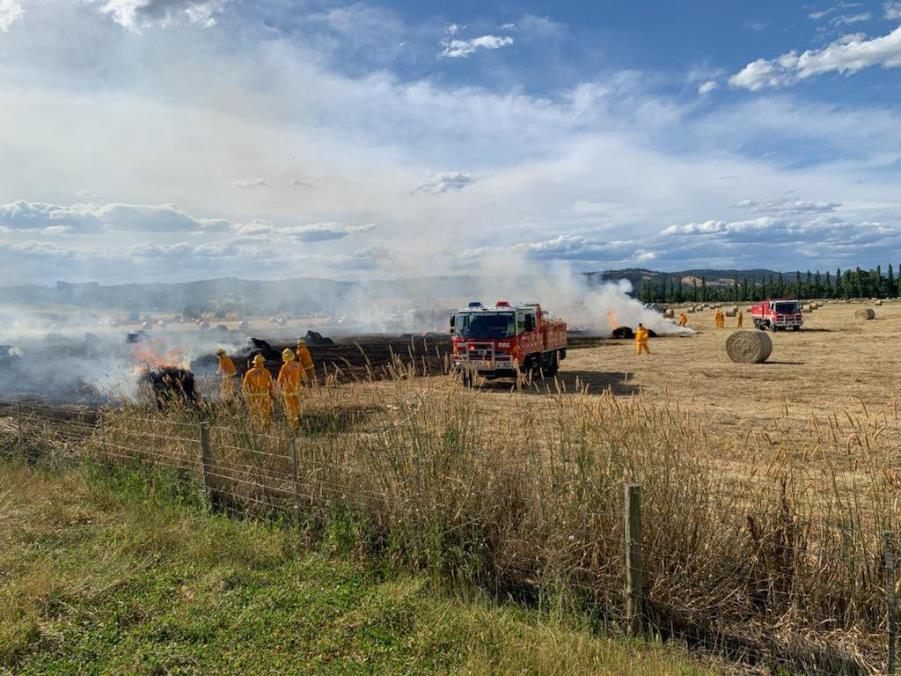
Victorian farmers have enjoyed strong seasonal growth of pastures and crops, but CFA has warned them to exercise caution when cutting, baling and storing hay.
The seasonal outlook for summer, released in late November by the Australasian Fire and Emergency Service Authorities Council (AFAC), showed most of Victoria received average to above average rainfall during winter and spring, but it was followed by a mostly dry December.
CFA volunteer firefighters responded to dozens of haystack fires across the state last year and District 13 Assistant Chief Fire Officer David Renkin said there have already been local incidents in recent weeks as grass has dried out in the area.
Firefighters were called to respond to a grassfire in Macintyre Lane, Yering, as recently as yesterday after a hay bale spontaneously combusted.
Responding to the call about 4.30pm, volunteer firefighters from Gruyere, Lilydale, Coldstream, Yarra Glen, Chirnside Park and Wonga Park were able to quickly bring the fire under control and establish control lines around 20 large haybales and a burnt area of about 2 hectares.
“The crews did a mighty job of stopping the spread of the fire into nearby uncut grass paddocks,” Assistant Chief Fire Officer David Renkin said.
“There is definitely a risk of spontaneous ignition in the area, usually caused by people baling hay too soon before it has dried properly.
“Over the last few weeks, we’ve seen more baling take place as grass dries out, but the intermittent rain is causing moisture.”
Spontaneous combustion can occur when hay has either not properly dried before baling, or has been exposed to rain or damp conditions, meaning moisture content in the bales is higher than the recommended levels.
“This can happen to any hay bales, regardless of size, and it is something farmers can help prevent,” ACFO Renkin said.
“After baling, make sure you check the heat and smell of the bales before stacking them into haysheds or large external stacks, and leave any suspect bales separate from the rest.
“By doing so, you’re not just protecting yourself from the financial impact of losing valuable fodder, you’ll also be helping your local brigade and community as haystack fires often occupy crucial firefighting resources during the season when CFA volunteer firefighters are required to monitor haystack fires for several days to make sure smouldering fires don’t spread.”
Important Tips
- It is important to ensure hay is well cured before bailing.
- Know the history of the hay you purchase.
- Keep haystacks to a limited size, and don't stack hay right to the top of a hay shed. Allow some air to circulate at the top - this helps to carry away moisture.
- Monitor moisture and temperature of your hay regularly.
- Watch for unusual odours such as pipe tobacco, caramel, burning or musty smells.
- Store hay in separate stacks or sheds away from farm equipment and other buildings.
- Keep your hay dry. Protect it from rain, leaking rooves or spouts, and runoff. Cover stacks with tarps or hay caps.
Temperature Guide – what to do when your hay is overheating
Use a thermometer in a probe or insert a crowbar into the middle of the stack for 2 hours
- Less than 50°C (can handle bar without discomfort): Check temperature daily.
- 50°C - 60°C (can only handle crowbar for short time): Check temperature twice daily. Remove machinery from shed.
- 60°C - 70°C (can touch bar only briefly): Check temperature every 2-4 hours. Move hay to improve air flow.
- Over 70 °C (bar is too hot to hold): Potential for fire. Call 000 immediately. Avoid walking on top of haystack.
For more information please visit: https://www.cfa.vic.gov.au/plan-prepare/hay-and-fire-safety